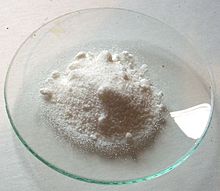This is an old revision of this page, as edited by Materialscientist (talk | contribs) at 01:50, 2 May 2011 (Reverted edits by Ebe123 (talk) to last version by CheMoBot). The present address (URL) is a permanent link to this revision, which may differ significantly from the current revision.
Revision as of 01:50, 2 May 2011 by Materialscientist (talk | contribs) (Reverted edits by Ebe123 (talk) to last version by CheMoBot)(diff) ← Previous revision | Latest revision (diff) | Newer revision → (diff) | |
| Names | |
|---|---|
| IUPAC name Ammonium docosaoxoheptamolybdate(6–) | |
| Other names
Ammonium molybdate Ammonium paramolybdate (see text) | |
| Identifiers | |
| CAS Number | |
| 3D model (JSmol) | |
| ChemSpider | |
| ECHA InfoCard | 100.031.553 |
| EC Number |
|
| UNII | |
| CompTox Dashboard (EPA) | |
InChI
| |
SMILES
| |
| Properties | |
| Chemical formula | (NH4)6Mo7O24 |
| Molar mass | 1163.9 g/mol 1235.86 g/mol (tetrahydrate) |
| Appearance | white to yellow-green crystalline solid |
| Density | 2.498 g/cm |
| Melting point | ~90 ˚C (loses water molecule) 190 °C (decomp.) |
| Solubility in water | 43 g/100 ml (tetrahydrate) |
| Hazards | |
| Occupational safety and health (OHS/OSH): | |
| Main hazards | Irritant |
| NFPA 704 (fire diamond) |
 |
| Flash point | Non-flammable |
| Related compounds | |
| Other anions | Ammonium orthomolybdate Ammonium dimolybdate |
| Other cations | Potassium paramolybdate |
| Except where otherwise noted, data are given for materials in their standard state (at 25 °C , 100 kPa).
| |
Ammonium heptamolybdate is an odourless crystalline compound ranging in colour from white to yellow-green. It is usually encountered as the tetrahydrate, whose chemical formula is (NH4)6Mo7O24·4H2O. It is often referred to as ammonium paramolybdate or simply as ammonium molybdate, although ammonium molybdate can also refer to ammonium orthomolybdate, (NH4)2MoO4, and several other species.
Synthesis
Ammonium heptamolybdate is easily prepared by dissolving molybdenum trioxide in an excess of aqueous ammonia and evaporating the solution at room temperature. While the solution evaporates, the excess of ammonia escapes. This method results in the formation of six-sided transparent prisms of the tetrahydrate of ammonium heptamolybdate.
Solutions of ammonium paramolybdate react with acids to form molybdic acid and an ammonium salt. The pH value of a concentrated solution will lie between 5 and 6.
Uses
- as an analytical reagent to measure the amount of phosphates, silicates, arsenates and lead in aqueous solution (e.g. pigments, river water, sea water etc.)
- in the production of molybdenum metal and ceramics
- in the preparation of dehydrogenation and desulphurisation catalysts
- in the fixing of metals
- in electroplating
- in fertilizers for crops.
- as a negative stain in biological electron microscopy, typically in the 3–5% (vol/vol) concentration range and in the presence of trehalose; or at saturated concentration to perform cryo-negative staining.
Safety
Ammonium paramolybdate is harmful if swallowed or inhaled. It causes irritation to the eyes, skin, and respiratory tract. It affects kidneys and blood.
References
- L. Svanberg & H. Struve, J. pr. Ch. 44 , p. 282; cited in Gmelin's Handbuch für Anorganische Chemie, 53, p. 255.
- Parsons, T.,Maita, V., & Lalli, C. (1984). A manual of chemical and biological methods for seawater analysis. Oxford: Pergamon.
- Harris, J.R. and Horne, R.W. 1991. Negative staining, in Harris J. R. (Ed.), Electron Microscopy in Biology, Oxford University Press, Oxford.
- Adrian, M., Dubochet, J., Fuller, S.D. and Harris, J.R. 1998. Cryo-negative Staining. Micron 29, p. 145–160; doi:10.1016/S0968-4328(97)00068-1.
- De Carlo, S., El-Bez, C., Alvarez-Rúa, C., Borge, J. and Dubochet, J. 2002. Cryo-negative staining reduces electron-beam sensitivity of vitrified biological particles. J. Struct. Biol. 138, p. 216–226; doi:10.1016/S1047-8477(02)00035-7; PMID 12217660.